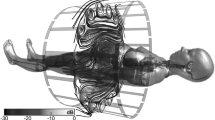Abstract
The magnetic resonance (MR) environment presents unique safety hazards for implanted and accessory medical devices including unwanted device movement, tissue heating, device malfunction, and imaging artifacts. Ever increasing numbers of patients with implants and accessory devices undergo MRI exams, making MRI safety an important goal for all. This paper provides an overview of the current status of standards related to the testing and labeling of medical devices in the MR environment. These standards represent the efforts and ongoing collaborations between regulatory bodies, device manufacturers, scientists, and the medical community to assure the safety of patients and medical personnel in the MR environment. This paper discusses current and emerging challenges to MRI safety evaluation that present opportunities for future standards development.

Similar content being viewed by others
References
Papers of particular interest, published recently, have been highlighted as: • Of importance •• Of major importance
Organisation for Economic Co-operation and Development, OECD Health Statistics 2014—Frequently Requested Data (2014) [Online]. http://www.oecd.org/els/health-systems/oecd-health-statistics-2014-frequently-requested-data.htm. Accessed 12 Feb 2016.
Klucznik RP, Carrier DA, Pyka R, Haid RW. Placement of a ferromagnetic intracerebral aneurysm clip in a magnetic field with a fatal outcome. Radiology. 1993;187:855–6.
CDRH. MDR Report # 2183553-2010-00007, [Online]. http://www.accessdata.fda.gov/scripts/cdrh/cfdocs/cfMAUDE/detail.cfm?mdrfoi__id=1648230 (2010). Accessed 12 Feb 2016.
Chen DW. Boy, 6, dies of skull injury during M.R.I., New York Times. New York; 2001. p. B1-B5.
CDRH [Online]. http://www.accessdata.fda.gov/scripts/cdrh/cfdocs/cfMDR/Detail.CFM?ID=540787 (1989). Accessed 12 Feb 2016.
CDRH [Online]. http://www.accessdata.fda.gov/scripts/cdrh/cfdocs/cfMAUDE/detail.cfm?mdrfoi__id=5116276 (2015). Accessed 12 Feb 2016.
CDRH [Online]. http://www.accessdata.fda.gov/scripts/cdrh/cfdocs/cfMDR/Detail.cfm?ID=434943 (1992). Accessed 12 Feb 2016.
CDRH. MDR Report # 2183553-2007-00003, [Online]. http://www.accessdata.fda.gov/scripts/cdrh/cfdocs/cfMAUDE/detail.cfm?mdrfoi__id=807089 (2007). Accessed 12 Feb 2016.
CDRH. MDR # 2240869-2014-02104, [Online]. http://www.accessdata.fda.gov/scripts/cdrh/cfdocs/cfMAUDE/detail.cfm?mdrfoi__id=3716520 (2014). Accessed 12 Feb 2016.
CDRH. MDR # 3003768277-2013-00001, [Online]. http://www.accessdata.fda.gov/scripts/cdrh/cfdocs/cfMAUDE/detail.cfm?mdrfoi__id=2930476 (2012). Accessed 12 Feb 2016.
CDRH. MDR # 3003768277-2011-00364, [Online]. http://www.accessdata.fda.gov/scripts/cdrh/cfdocs/cfMAUDE/detail.cfm?mdrfoi__id=2100792 (2011). Accessed 12 Feb 2016.
CDRH. MDR # 2183553-2010-00001. [Online]. http://www.accessdata.fda.gov/scripts/cdrh/cfdocs/cfMAUDE/detail.cfm?mdrfoi__id=1578579 (2009). Accessed 12 Feb 2016.
Henderson JM, et al. Permanent neurological deficit related to magnetic resonance imaging in a patient with implanted deep brain stimulation electrodes for Parkinson’s disease: case report. Neurosurgery. 2005;57:1063.
CDRH. [Online]. http://www.accessdata.fda.gov/scripts/cdrh/cfdocs/cfMDR/Detail.cfm?ID=533737 (1990). Accessed 12 Feb 2016.
ASTM F2052 Standard Test Method for Measurement of Magnetically Induced Displacement Force on Medical Devices in the Magnetic Resonance Environment, copyright ASTM International, 100 Barr Harbor Drive, West Conshohocken, PA 19428.
ASTM F2213 Standard Test Method for Measurement of Magnetically Induced Torque on Medical Devices in the Magnetic Resonance Environment, copyright ASTM International, 100 Barr Harbor Drive, West Conshohocken, PA 19428.
•• ASTM F2503 Standard Practice for Marking Medical Devices and Other Items for Safety in the Magnetic Resonance Environment, copyright ASTM International, 100 Barr Harbor Drive, West Conshohocken, PA 19428. This standard defines the standard terms and icons, MR Safe, MR Conditional, and MR Unsafe used to label items for their safety status in the MR environment. Standard test methods ASTM F2052, F2213, F2182, and F2119 provide methods for assessing the safety of an item in the MR environment.
ASTM F2182 Standard Test Method for Measurement of Measurement of Radio Frequency Induced Heating Near Passive Implants During Magnetic Resonance Imaging, copyright ASTM International, 100 Barr Harbor Drive, West Conshohocken, PA 19428.
ASTM F2119 Standard Test Method for Evaluation of MR Image Artifacts from Passive Implants, copyright ASTM International, 100 Barr Harbor Drive, West Conshohocken, PA 19428.
CDRH. Guidance for Industry and FDA Staff Establishing Safety and Compatibility of Passive Implants in the Magnetic Resonance (MR) Environment, [Online]. http://www.fda.gov/ucm/groups/fdagov-public/@fdagov-meddev-gen/documents/document/ucm107708.pdf (2014). Accessed 12 Feb 2016.
• ISO/TS 10974 Assessment of the safety of magnetic resonance imaging for patients with an active implantable medical device, ISO, 1, rue de Varembé, Case postale 56, CH-1211 Geneva 20, Switzerland. This standard defines that hazards that must be addressed to assess the safety of an active implant and provides methods for addressing each hazard.
ISO 14708-03/Ed.2, Implants for surgery—active implantable medical devices—Part 3: implantable neurostimulators, ISO, 1, rue de Varembé, Case postale 56, CH-1211 Geneva 20, Switzerland.
AAMI. AAMI PC76/Ed.1, Active implantable medical devices - Requirements and test protocols for safety of patients with pacemakers and ICDs exposed to magnetic resonance imaging, in development, [Online]. https://standards.aami.org/kws/public/projects/project/details?project_id=51 (2015). Accessed 12 Feb 2016.
AAMI. AAMI CI86/Ed.1, Cochlear Implant Systems: Requirements for Safety, Functional Verification, Labeling and Reliability Reporting, in development, [Online]. https://standards.aami.org/kws/public/projects/project/details?project_id=24 (2015). Accessed 12 Feb 2016.
ISO 14630 Non-active surgical implants—general requirements, ISO, 1, rue de Varembé, Case postale 56, CH-1211 Geneva 20, Switzerland.
ISO 14708-1 Implants for surgery—active implantable medical devices—part 1: general requirements for safety, marking and for information to be provided by the manufacturer, ISO, 1, rue de Varembé, Case postale 56, CH-1211 Geneva 20, Switzerland.
IEC 62570:2014 Standard practice for marking medical devices and other items for safety in the magnetic resonance environment, IEC, 3, rue de Varembé, P.O. Box 131, CH-1211 Geneva 20, Switzerland.
IEC 60601-2-33: Particular requirements for the basic safety and essential performance of Magnetic Resonance Diagnostic Equipment, IEC, 3, rue de Varembé, P.O. Box 131, CH-1211 Geneva 20, Switzerland.
Author information
Authors and Affiliations
Corresponding author
Additional information
This article is part of the Topical Collection on MRI Safety.
Rights and permissions
About this article
Cite this article
Delfino, J.G., Woods, T.O. New Developments in Standards for MRI Safety Testing of Medical Devices. Curr Radiol Rep 4, 28 (2016). https://doi.org/10.1007/s40134-016-0155-y
Published:
DOI: https://doi.org/10.1007/s40134-016-0155-y




